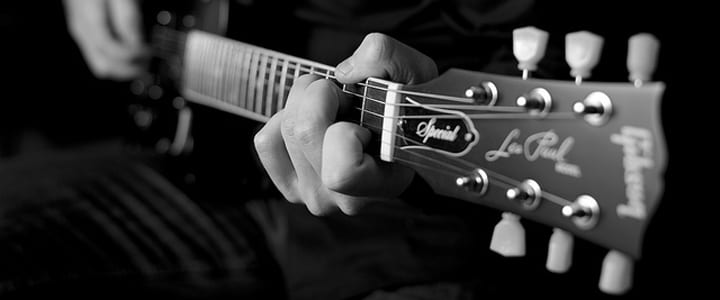Ten Best Tips and Tricks for Learning Guitar Chords
By Team HC |
The Ten Best Tips and Tricks for Learning Guitar Chords
 Ready to learn guitar chords? Guitar teacher Joe H. shares his secrets to mastering guitar chords…
Ready to learn guitar chords? Guitar teacher Joe H. shares his secrets to mastering guitar chords…
The guitar is incredibly versatile accompaniment instrument. It can deliver many effects, from driving strumming to delicate fingerpicking. It is essential that a guitarist have a solid vocabulary of chords to draw from to do this. Let’s be honest for moment: There are hundreds of chords! The good news is that some are more essential than others (more on that later). The following ten tips and tricks for learning guitar chords should help get them in your head and under your fingers in no time!
1. Have a Plan
When you are just starting to learn chords it is important to make a practice plan. You will want to look honestly at the time you have each week to dedicate to practicing and choose realistic goals for yourself. You may choose to try to learn three new chords a week (a reasonable goal for beginners), maybe five, or maybe even just one. The most vital thing is that you set a goal based on your personal learning style and current abilities!
2. Have Excellent Resources
When learning anything, it’s very important to have reliable sources. Ask a friend or even better, a guitar teacher, for some recommendations. Most beginner guitar method books have a limited chord resource in the back that can help you begin. Once you progress beyond the basic chords however, you will definitely want to invest in a more advanced resource such as a chord dictionary where you can find just about any chord you could imagine!
3. Learn to Read Chord Diagrams
Chord diagrams (a.k.a. chord charts) are visual representations of a portion of the guitar neck in which all the information necessary to learn a chord can be written. These are the most common and useful way of quickly notating chords so we can instantly relate them to the guitar. They are a must!
4. Start with Open Chords
Open chords are essential knowledge for all aspiring guitarists. These are chords in which one or more of the strings are played open (without being fretted). Because we don’t need to push down all of the notes in the chord it can be easier to get a clear sound as opposed to chords with no open strings.
5. Know What You Need To Know
It is important when you are deciding to learn guitar chords that you know what types of chords will lend themselves to the type of music in which you are interested. For instance, styles such as folk, pop and rock will stick with mostly with open and barre forms of major, minor and some basic seventh chords. Styles such as jazz and progressive rock require a more extensive understanding and knowledge of extended chords such as major, minor and dominant 9th, 11th and 13th chords and their many variations.
6. Make Sure You Are Practicing Correctly
You are going to want to make sure you build good habits when practicing chords. Just because your fingers are in the correct places does not mean you will be sounding the chord correctly. You can assess this by playing each string in the chord one at a time and listening for muffled or muted notes. If you hear a note that sounds incorrectly, you will want to adjust your fingers. Remember it is important to push the fingertip straight into the fretboard whenever possible to prevent accidentally muting strings adjacent to those intended. You can always move your thumb further down the back of the neck to help your fingers more easily hold down the upper strings at the proper angles.
7. Understand Movable Shapes: Barre Chords
Keep in mind that any chord shape you learn that does not contain any open strings (barre chords) can be moved and used as the same type of chord except under a different root (The note a chord is named after). For instance, if you move every note in an F Major Barre Chord up 2 frets from the 1st the 3rd fret, that same shape now lets you play a G Major Chord. If this is lost on you at the moment, check out tip #9!
8. Give Context To What You are Learning
Make sure you pick out some songs that interest you and will really motivate you to learn. Finding songs that you like with chords you haven’t learned yet is a great way to stay on the path and keep yourself driving forward!
9. Learn Some Music Theory
Having even a basic understanding of how chords are built will help you figure out how to play chords without needing a resource to show you. Music theory empowers you to not be just a guitarist but a full-blown musician as well!
10. Find a Great Teacher
Truly the best approach to learn chords is to have an excellent teacher to teach you in a way custom tailored to you!
With these ten tips in mind, remember: the secret to learning guitar chords is repetition. Try to play your newest chords at least a couple times each day or at least every time you pick up the guitar. Good luck!
Looking for a guitar teacher who can help you learn guitar chords? Find your perfect guitar teacher today and make your guitar-playing dreams come true!
___________________________________

Joe H. is a guitar and music theory instructor in White Plains, NY. Teaching since 2009, he received a degree in Jazz Studies from SUNY Purchase Conservatory of Music and can help students specialize in blues or country guitar. Learn more about Joe here!
Used with the express written permission of takelessons.com



Recommended Comments
There are no comments to display.